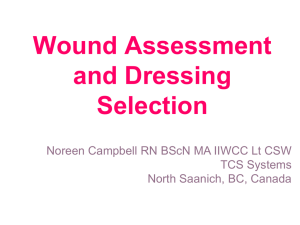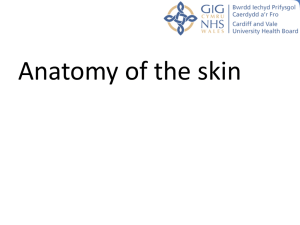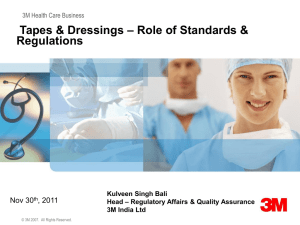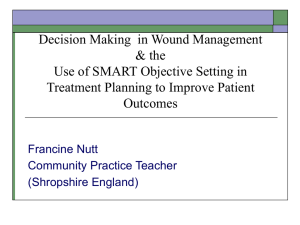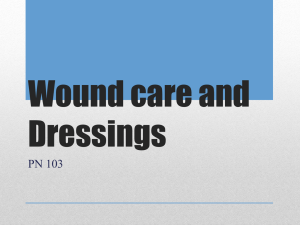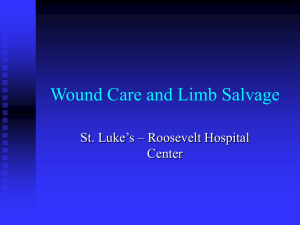wound care:it`s all greek to me
advertisement
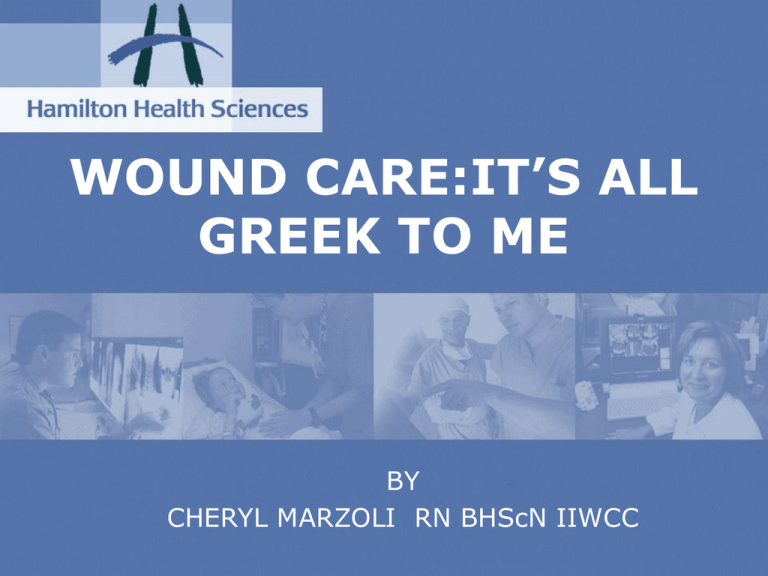
WOUND CARE:IT’S ALL GREEK TO ME BY CHERYL MARZOLI RN BHScN IIWCC OBJECTIVES • Provide a better understanding of wound care • How to: assess, provide interventions and document about wounds. • Understanding moist wound healing • Discuss categories of dressing products, the use of the products, NPT (negative pressure therapy) and treatment of wounds. WOUND • DEFINITION: A wound is a bodily injury caused by physical means, with disruption of the normal continuity of structures. This can be identified as an acute or a chronic wound. • ACUTE: Heals in approximately 2 weeks to 6 months • CHRONIC: Takes 6 months or more. ACUTE WOUND CHRONIC WOUND PHASES OF WOUND HEALING • Stages of wound healing: Hemostasis: immediate response Inflammation: 0-4 days Proliferation: 4-21 days Granulation (Epithelialization) :4-21 days Remodeling: up to 2 years * this is for acute wounds, chronic wounds fail to progress naturally PHASE GOAL PRINCIPLE WOUND CELL HOUSE BUILDING CONTRACTOR 1 HEMOSTASIS PLATELETS CAPPING OFF OFFENDING CONDUITS 2 INFLAMMATION NEUTROPHILS UNSKILLED LABORERS CLEAR THE SITE 3 PROLIFERATION MACROPHAGES SUPERVISOR CELL GRANULATION LYMPHOCYTES SPECIFIC PREPARERS OF SITE PLUMBER, ELECTRICIAN FRAMERS ROOFERS/SIDERS CONTRACTURE 4 REMODELING ANGIOCYTES, NEUROCYTES FIBROBLASTS, KERATINOCYTES FIBROCYTES REMODELERS *Krasner, et al STAGES OF PRESSURE ULCERS Stage Stage Stage Stage 1: 2: 3: 4: reddened skin blister (painful), shallow, pink ulcer through the dermis through to underlying structures (bone, tendons, etc.) Unable to stage: unable to visualize wound bed due to eschar/slough Suspected Deep Tissue Injury (SDTI): purple localized area of discolored intact skin, boggy, warmer or cooler compared to adjacent tissues. NOTE: NO reverse staging i.e. once a stage 3 always a stage 3, never changes to stage 2 STAGE ONE •Epidermis intact •Area reddened •Does not disappear when pressure relieved •No drainage •Reversible STAGE TWO STAGE THREE STAGE FOUR UNABLE TO STAGE WHAT STAGE? WHAT STAGE? STAGING ALL OTHER WOUNDS NOT PRESSURE ULCERS Classification is based on the 3 layers of skin Classify as superficial, partial or full thickness i.e. a burn can be partial thickness (second layer). PARTIAL THICKNESS BURN ASSESS THE PATIENT 1.Look at the whole patient not just the hole. 2. What are the patient’s concerns? 3. Is the wound new or old and how old? 4. Is this wound healable? 5. What are the patient’s co-morbidities? 6. How is the patients nutritional status 7. What medications if any could interfere with wound healing? Probe the wound!!!! Try and correct the causes that may delay wound healing • • • • • • Edema Nutrition/Dietary consult Alter medications Glycemic control Treat infection OT/Physio consult Documentation • • • • • • • • Slough Eschar Granulation Undermining Erythema Maceration Exudate Odor * Location * Size LxWxD Moist Wound Healing Motto… If If If If If its its its its its wet……..DRY it! dry………MOISTEN it! irritated…SOOTHE it! chronic…IRRITATE it! palliative..COMFORT it! Contamination, Colonization or Infection Contamination: Bacteria-not attached to wound bed -are not replicating Colonization: - Bacteria are attached to the wound surface but are not replicating Infected: -Bacteria are invasive, replication and interfering with wound healing process -may lead to a “HOST RESPONSE” leading to systemic infection SWABS • Always take a swab from a newly cleaned wound. • Cleanse with normal saline or sterile water • Take a swab by moving in a “Z” pattern over the wound and turning the swab at the same time • Punch biopsy (Physician only) • Do Not swab necrotic or slough tissue Wound Cleansing - Normal Saline or Sterile Water – Irrigate with 20-30 ml syringe – Use 18 angiocath – 4-6 inches above the wound – 5-15 PSI • **MMP’S( matrix metalloproteases) ANTISEPTIC SOLUTIONS • • • • • • Acetic acid: pseudomonas Proviodine: broad spectrum effectiveness Hygeol: staph. and strep. mechanical debridement control odour *acetic acid and hygeol are available through the pharmacy Wound Care Products – – – – – – – – – – Liquid barrier Transparent films Hydrocolloids Gauze dressings Hydrogels Foam dressings Absorptive dressings Calcium alginate Charcoal dressings Silver coated dressings -non adherent dressings -debriding agents -antiseptic LIQUID BARRIER TRANSPARENT FILM HYDROCOLLOID • GAUZE DRESSINGS HYDROGEL FOAM DRESSING ABSORBENT DRESSINGS CALCIUM ALGINATE ODOUR CONTROL CHARCOAL DRESSINGS ANTIMICROBIAL DRESSING OTHER DRESSINGS • Non adherent dressings• i.e.- mepital • Debriding agents-mesalt, iodosorb • Antiseptic- bactigras with a chlorhexidine base BIOLOGIC DRESSINGS BIOLOGIC DRESSINGS NEGATIVE PRESSURE THERAPY • WATCH FOR PRECAUTIONS AND CONTRAINDICATIONS WHEN ORDERING • MAKE SURE WOUND IS MEASURED ON INITIAL APPLICATION • IF NO CHANGE WITHIN 2-2I/2 WEEKS THEN DISCONTINUE • E-Z CARE IS A NEW NEGATIVE PRESSURE THERAPY GOOD CANDIDATE FOR NEGATIVE PRESSURE QUESTIONS THANKYOU
